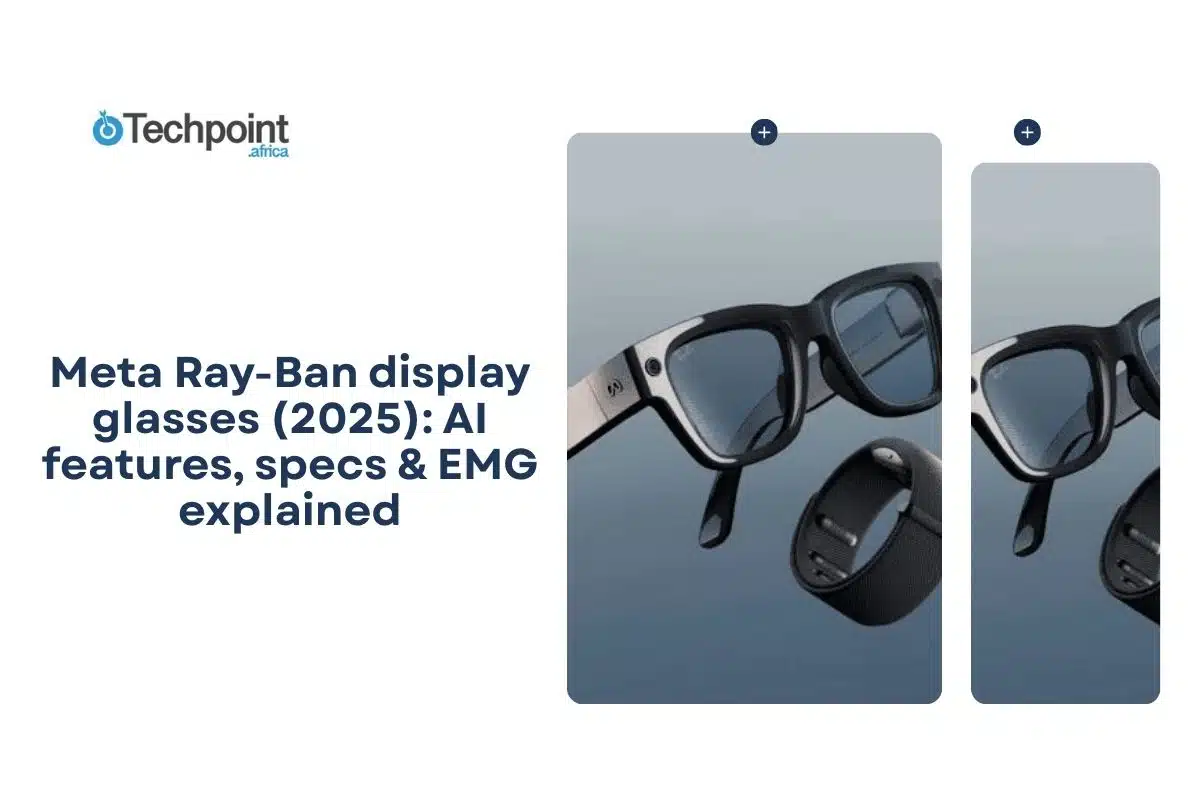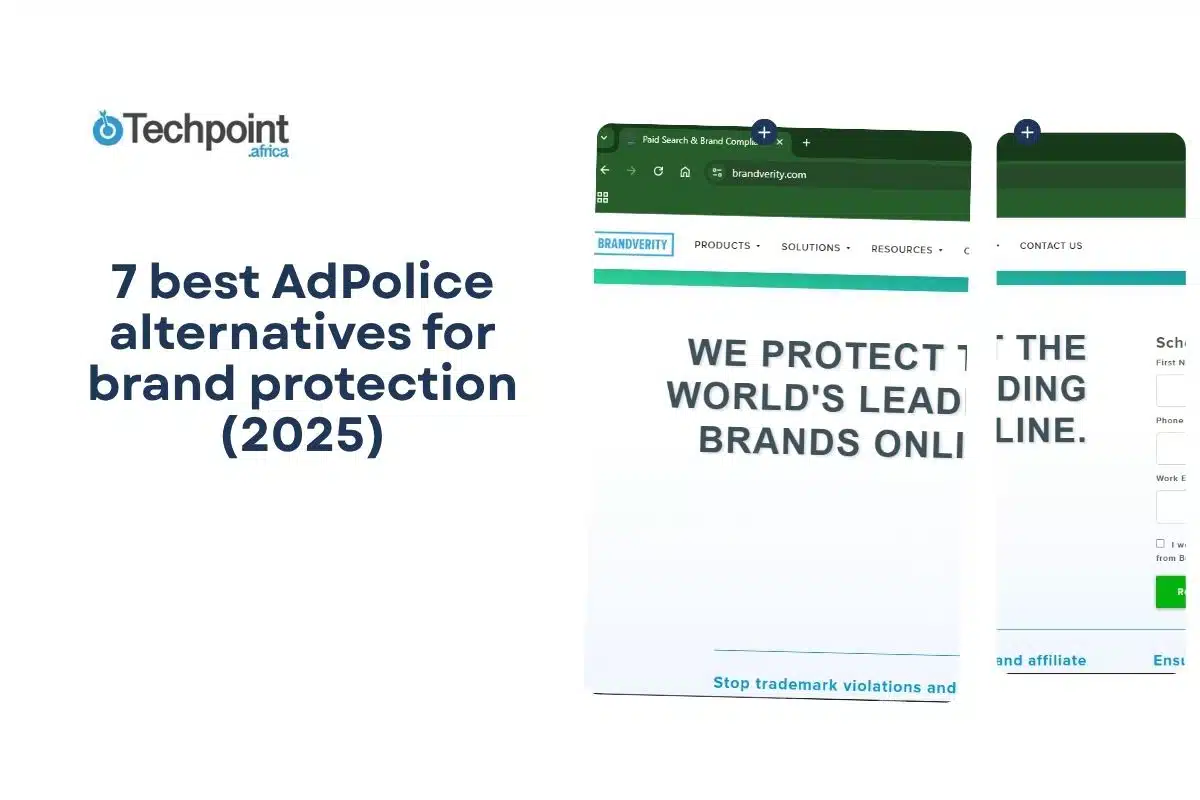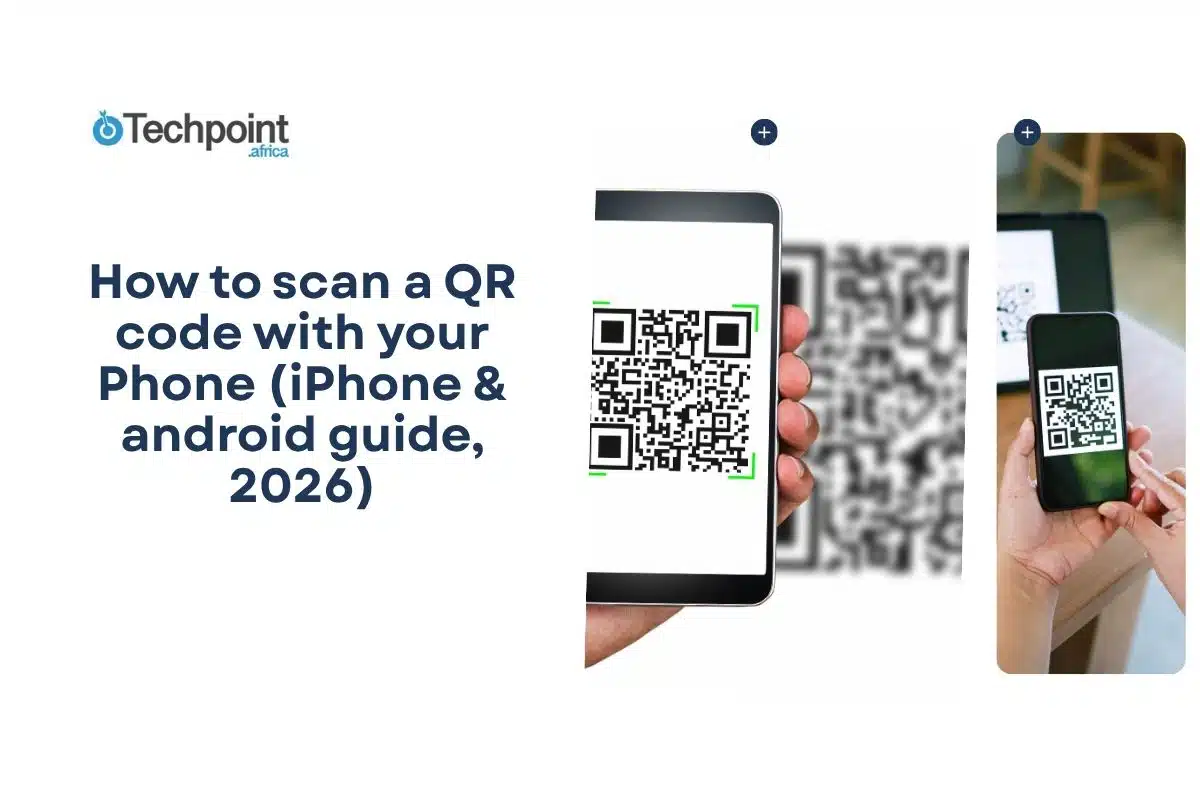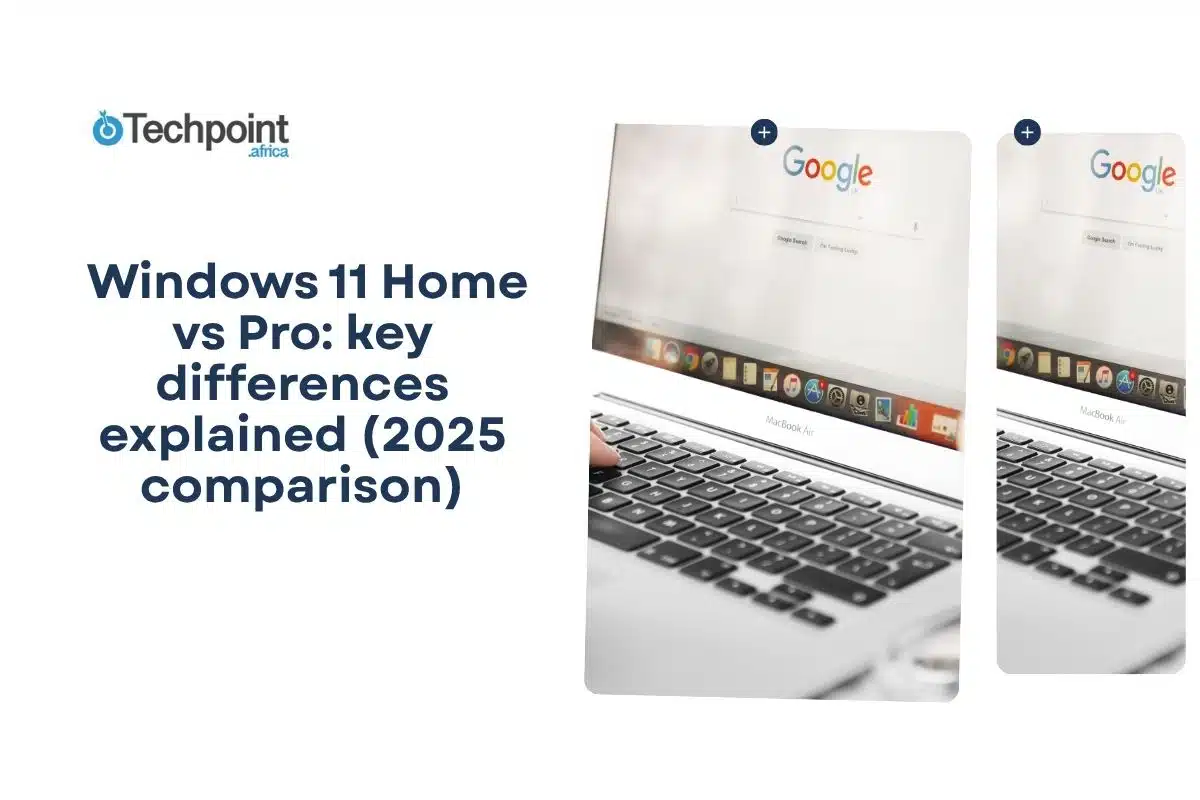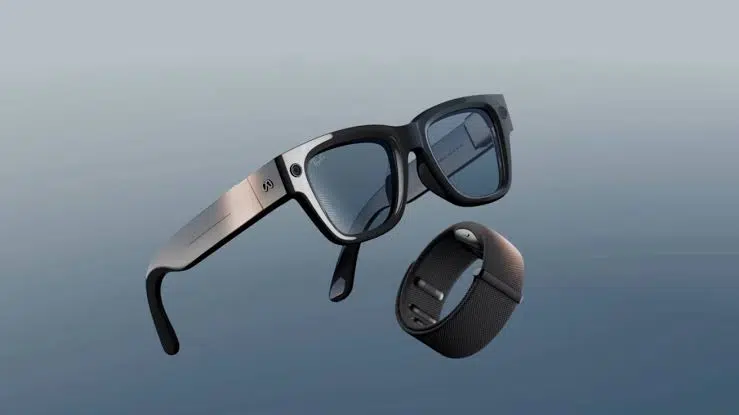
The first Ray-Ban Meta glasses hinted at a future where style meets tech. Now, the 2025 Meta Ray-Ban Display Glasses push that vision further, packing AI smarts and a futuristic EMG wristband into a design you’ll actually want to wear. From smarter notifications to hands-free controls, these glasses aim to change how you see and interact with the world.
In this guide, you will learn:
- How the Meta Ray-Ban Display Glasses Integrate AI into Everyday Life.
- What the EMG wristband does and how it changes user interaction.
- Key specs, performance, and battery details.
- Pricing, availability, and early impressions from reviews.
Design & display
Meta’s 2025 Ray-Ban Display Glasses keep the iconic Wayfarer look while integrating futuristic technology. They are slightly heavier than the previous model but remain comfortable for daily wear. The in-lens display offers crisp visuals and a wide field of view, with brightness that adapts to different lighting conditions.

Meta Ray-Ban Display Glasses (2025) – Key Specs
| Features | Speculation |
| Frame style | Wayfarer |
| Weight | 60g |
| Lens display resolution | 600×600 pixels |
| Field of view | 20° (42 pixels per degree) |
| Display refresh rate | 90Hz (content 30Hz) |
| Brightness | 30 – 5,000 nits |
| Light leakage | <2% |
| Connectivity | Bluetooth 5.3, Wi-Fi 6 |
| Battery life | Up to 6 hours (glasses), 24 hours with charging case |
| EMG Wristband | Meta Neural Band, gesture control |
The combination of classic design and advanced display specs ensures the glasses are both stylish and functional, making them suitable for extended use in various environments.
Frame sizes
The Meta Ray-Ban Display Glasses are available in two frame sizes: Standard and Large. The Standard size weighs approximately 69 grams, while the Large size is slightly heavier at 70 grams. These sizes are designed to accommodate a range of face shapes and sizes, ensuring a comfortable fit for most users. Additionally, the glasses come in two color options: Black and Sand. They are compatible with prescription lenses, enabling users to tailor them to their specific vision needs.
AI features & advanced capabilities
Meta’s 2025 Ray-Ban Display Glasses redefine wearable technology by seamlessly integrating AI into both everyday tasks and advanced interactions. From messaging to contextual assistance, here’s how these glasses elevate smart eyewear:
Essential AI Features
- Live Captions & Real-Time Translation: The glasses display live captions for conversations and translate select languages in real-time, making multilingual interactions effortless.
- Visual Responses & Step-by-Step Assistance: Meta AI provides visual guidance directly within the lens, offering answers and instructions for tasks without interrupting your workflow.
- Private Messaging Display: Receive messages from platforms like WhatsApp, Messenger, and Instagram discreetly in-lens, keeping you connected without constantly checking your phone.
- Live Video Calling & Screen Sharing: Conduct video calls and share your screen directly from the glasses, ideal for meetings and collaborative work.
- Turn-by-Turn Navigation: Visual maps and directions guide you to destinations efficiently, currently available in select cities.
- Camera Viewfinder & Zoom Functionality: Frame shots and zoom directly through the lenses, enabling spontaneous photography.
- Music Playback Controls: Manage music hands-free, with album art and track info visible in-lens.
Advanced AI Capabilities
- Context-Aware Assistance: The glasses detect your surroundings and provide relevant suggestions, such as nearby landmarks, restaurants, or public transport options.
- Predictive Interaction: AI learns your habits to anticipate notifications or suggest quick replies, minimizing manual interaction.
- Enhanced Visual Recognition: Object and facial recognition deliver contextual information, such as attendee names during meetings (with consent).
- AI-Powered Translation & Captioning: Supports live, multilingual conversations, dynamically adjusting captions for clarity amid background noise or multiple speakers.
- Meta Ecosystem Integration: Syncs with Meta’s AI ecosystem, learning user preferences over time to optimize notifications, AR apps, and other interactions.
Meta Neural Band: The EMG Wristband
Meta’s Neural Band introduces a groundbreaking approach to controlling smart glasses through subtle muscle movements. Here’s an in-depth look at its features and capabilities:
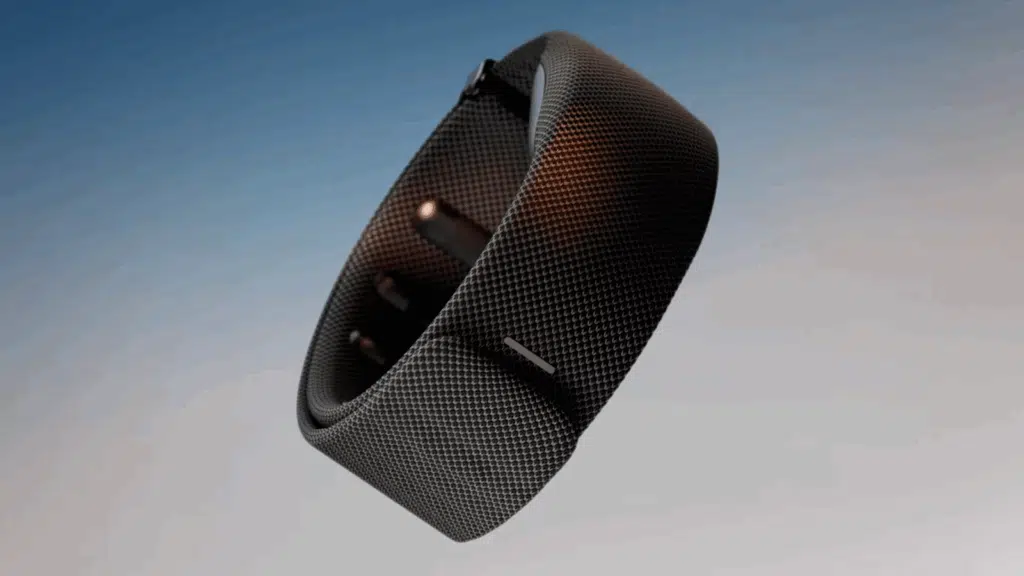
- EMG Technology for Gesture Control
The Neural Band utilizes surface electromyography (sEMG) technology to detect electrical signals generated by muscle activity in the wrist. This allows for intuitive control of the Meta Ray-Ban Display Glasses using subtle hand gestures, such as finger movements, without the need for touch or voice commands. This technology was developed using deep learning algorithms based on data from nearly 200,000 consenting research participants, ensuring broad usability across different users.
- Seamless Integration with Smart Glasses
Each pair of Meta Ray-Ban Display Glasses comes bundled with the Neural Band. This integration enables users to interact with their glasses effortlessly, translating muscle signals into digital commands. Whether it’s scrolling through notifications, adjusting settings, or navigating through applications, the Neural Band provides a natural and unobtrusive method of control.
- Battery Life and Charging
The Neural Band offers up to 18 hours of battery life on a single charge, ensuring extended usage throughout the day. It charges separately from the glasses and includes a charging case that provides up to 24 additional hours of usage, allowing users to stay connected without frequent recharging.
- Water Resistance
Designed for daily wear, the Neural Band boasts an IPX7 water resistance rating, making it suitable for various environments and activities, including workouts and outdoor use.
- Future Potential
While the current iteration of the Neural Band focuses on gesture control for the Meta Ray-Ban Display Glasses, Meta envisions expanding its capabilities in future versions. Potential enhancements include integrating fitness tracking features and broader compatibility with other devices, further enhancing the user experience.
Performance & Battery Life
The Meta Ray-Ban Display Glasses (2025) are designed for daily use, balancing advanced functionality with solid battery performance.
- Glasses Battery Life
The glasses themselves offer up to 6 hours of mixed-use battery life. This includes running AI features, displaying notifications, live captions, and camera use. While this is slightly lower than a smartphone battery, the glasses are meant for short bursts of interaction throughout the day, rather than continuous heavy use.
The included charging case boosts total usage to up to 24 hours, letting users recharge on the go. The case is compact enough to carry in a bag or pocket, making it convenient for daily wearers.
- Neural Band Battery Life
The Meta Neural Band supports up to 18 hours of battery life per charge. Because it’s designed to detect EMG signals and translate them into commands continuously, it consumes power efficiently. Users can pair it with the glasses and rely on the band all day without worrying about mid-use charging.
- Charging Methods
Both the glasses and the Neural Band offer convenient charging options. The glasses charge via a magnetic USB-C cable connected to their compact charging case, while the Neural Band uses a separate proprietary magnetic charger included in the box. Both devices support fast charging, providing several hours of use from just a short charging session
- Real-World Performance
According to hands-on tests (Tom’s Guide), the glasses and Neural Band maintain smooth performance even when running multiple AI tasks simultaneously. Navigation, notifications, and live captions run without noticeable lag, and the EMG gestures are responsive and accurate.
Privacy & Security
With cameras, AI sensors, and always-on displays, privacy is a major consideration for smart glasses, and Meta has taken steps to address it. The Meta Ray-Ban Display Glasses feature a built-in LED indicator that illuminates whenever the camera is active, providing a visible cue to nearby individuals. This helps ensure that the recording is transparent and reduces concerns about discreet video capture.
Meta also emphasizes user data protection. Video and sensor data are processed on-device whenever possible, minimizing what is sent to Meta’s servers. Any cloud-based processing is encrypted, and the glasses require explicit user consent for AI features, notifications, and live translations.
Despite these safeguards, experts note that the glasses could still raise privacy questions in certain settings, especially in public spaces or workplaces. Users are encouraged to remain aware of local privacy regulations and social norms while using the device.
Pricing, Availability & Reception
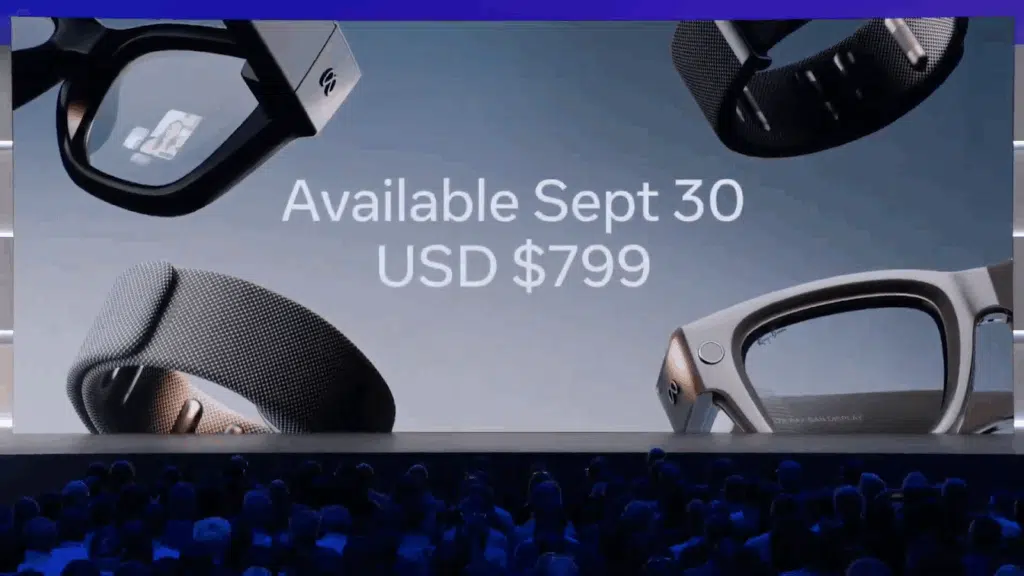
The Meta Ray-Ban Display Glasses (2025), priced at $799, launched in the U.S. on September 30, 2025. This price includes both the glasses and the Meta Neural Band. They are available in Black and Sand colors, with two frame sizes: Standard and Large. The glasses feature Transitions lenses, allowing wearers to seamlessly transition between indoor and outdoor use. They are available at select retailers such as Best Buy, LensCrafters, Sunglass Hut, and Ray-Ban Stores. Additionally, Verizon locations will carry the glasses soon after the initial release.
The Meta Neural Band, an EMG wristband that translates muscle signals into digital commands, is included with the glasses. It offers up to 18 hours of battery life and is water-resistant with an IPX7 rating, making it suitable for various activities.
Despite a rocky start during the live demo at Meta Connect 2025, where technical glitches disrupted the presentation, early reviews have been generally positive. Tom’s Guide highlighted the glasses as “the best smart glasses” they’ve tested, praising the crisp display, intuitive wrist gestures, and advanced AI features. However, they noted that the glasses are slightly heavier than previous models and come with a premium price tag.
Meta plans to expand availability to Canada, France, Italy, and the United Kingdom in early 2026, aiming to broaden the reach of its innovative smart eyewear.
Pros
- Advanced AI Integration: Offers real-time translations, live captions, and Meta AI-powered assistance, enhancing user experience.
- Gesture Control via Neural Band: The EMG wristband allows for discreet interaction through subtle hand movements, eliminating the need for voice commands or touch.
- High-Resolution Display: The in-lens display provides clear visuals, readable even in bright sunlight, with a peak brightness of 5,000 nits.
- Comprehensive Communication Features: Supports live video calls, messaging, and navigation, consolidating multiple functions into a single device.
- Prescription Lens Compatibility: Users can integrate their prescription lenses, making the glasses suitable for everyday wear.
Cons
- Battery Life Limitations: The glasses offer up to 6 hours of use per charge, which may require frequent recharging during extended use.
- Weight Considerations: At 69–70 grams, the glasses are slightly heavier than traditional eyewear, which might affect comfort during prolonged wear.
- Limited Style Options: Currently available in only two frame sizes and two colors, limiting personalization choices.
- Privacy Concerns: The always-on camera and microphone may raise privacy issues in certain settings, despite the inclusion of an LED indicator when the camera is active.
- Dependence on Smartphone: Requires pairing with a smartphone for full functionality, lacking standalone capabilities.
Final Takeaways
- Meta Ray-Ban Display Glasses (2025) combine classic style with advanced AI features for hands-free interactions.
- The Meta Neural Band enables intuitive gesture control, making navigation and commands effortless.
- High-resolution displays, messaging, and translation features enhance daily usability, though battery life and weight are considerations.
Conclusion
The 2025 Meta Ray-Ban Display Glasses take smart eyewear a step further, blending familiar design with AI features that actually make sense in daily life. From translations and captions to gesture controls, they show what’s possible when tech meets style—without overcomplicating things. Not perfect, but definitely a glimpse at the future of connected glasses.

